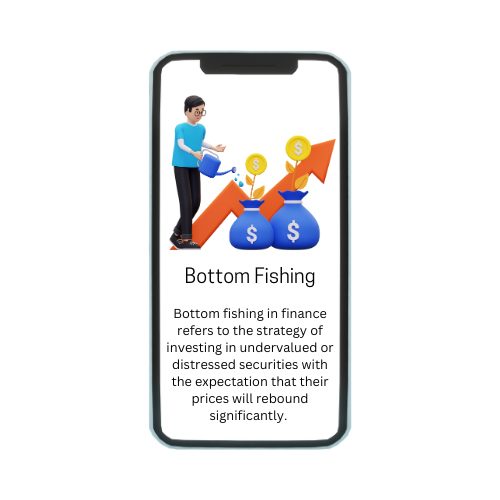Bottom fishing in finance refers to the strategy of investing in undervalued or distressed securities with the expectation that their prices will rebound significantly. This approach is based on the belief that these assets are trading at or near their lowest possible value, presenting a buying opportunity. Investors practicing bottom fishing typically target companies or sectors experiencing temporary difficulties or adverse conditions that have led to depressed stock prices. The goal is to purchase these assets at a low price before the market recognizes their true value and the prices increase. This strategy requires careful analysis and a high tolerance for risk, as the investments made may still face significant challenges or may not recover as anticipated.
Understanding Bottom Fishing
Bottom fishing is an investment strategy where investors seek to acquire undervalued or distressed assets that are believed to be trading at or near their lowest price. The fundamental idea behind this approach is to capitalize on opportunities where the market has excessively punished certain securities, often due to temporary setbacks or negative sentiment, rather than long-term fundamental issues. Investors engaging in bottom fishing meticulously analyze financial health, market conditions, and potential recovery signs to identify these low-priced assets. The strategy assumes that these investments are poised for a rebound once the market corrects its perception, thus offering substantial returns when prices eventually recover. However, bottom fishing involves inherent risks, including the possibility that the assets may not recover or that underlying issues may persist, making it a high-risk, high-reward approach.
Identifying Potential Stocks for Bottom Fishing
Identifying potential stocks for bottom fishing involves a thorough analysis to find undervalued or distressed equities that are believed to be trading at or near their lowest price. This process starts with screening for stocks that have experienced significant declines due to short-term issues, market overreactions, or temporary setbacks, rather than fundamental problems. Investors often look for companies with solid long-term prospects but currently facing challenges such as poor earnings reports, market volatility, or sector-specific downturns. Key criteria in this evaluation include assessing the company’s financial health, including its balance sheet strength, cash flow stability, and debt levels. Additionally, investors consider qualitative factors such as management quality, industry position, and potential for recovery. By combining both quantitative metrics and qualitative insights, investors aim to identify stocks that are undervalued and have the potential for significant price appreciation once the market corrects its perception of the company.
Benefits of Bottom Fishing
- Potential for High Returns: Bottom fishing targets undervalued or distressed assets with the expectation of significant price rebounds, offering the potential for substantial returns when the market corrects its valuation.
- Buying at a Discount: This strategy allows investors to purchase stocks at a lower price than their intrinsic value, providing a margin of safety and increasing the likelihood of profit if the market recovers.
- Long-Term Investment Opportunities: Investing in undervalued stocks often involves companies with strong fundamentals that are temporarily out of favor, which can lead to long-term growth and value creation once conditions improve.
- Diversification Benefits: Bottom fishing can provide access to new or less correlated sectors, potentially enhancing portfolio diversification and reducing overall investment risk.
- Market Efficiency: By identifying and investing in undervalued assets, bottom fishing helps correct market inefficiencies, contributing to more accurate pricing of securities in the long run.
Risks and Challenges of Bottom Fishing
- Potential for Further Decline: One of the primary risks is that the stock’s price may continue to fall, especially if the underlying issues are more severe or persistent than initially assessed, leading to greater losses.
- Uncertain Recovery: There is no guarantee that the distressed asset will recover, as the anticipated rebound may not materialize if market conditions remain unfavorable or if the company faces ongoing operational difficulties.
- Increased Volatility: Stocks targeted for bottom fishing often exhibit higher volatility and risk, which can lead to significant price swings and affect the stability of the investment.
- Extended Holding Period: Recovery of undervalued stocks may take longer than expected, requiring investors to hold onto these assets for extended periods while waiting for a potential rebound.
- Difficulty in Accurate Valuation: Determining the true value of distressed assets can be challenging due to complex factors affecting their performance, making it difficult to accurately assess the potential for recovery and value.
Bottom Fishing vs. Other Investment Strategies
Bottom fishing is distinct from other investment strategies primarily in its focus on acquiring undervalued or distressed assets with the expectation of significant price recovery. Unlike growth investing, which targets companies with high potential for future earnings growth, bottom fishing emphasizes purchasing assets currently trading at low prices due to short-term issues or market overreactions. In contrast to value investing, which seeks undervalued stocks based on fundamental analysis and intrinsic value, bottom fishing often involves higher risk due to the distressed nature of the assets. It also differs from momentum investing, which involves buying stocks with strong recent performance trends and selling those with poor performance, as bottom fishing targets assets that may not currently be performing well but are expected to rebound. Additionally, while passive investing strategies involve minimal buying and selling based on market indices, bottom fishing requires active management and careful analysis to identify and capitalize on undervalued opportunities. Each strategy has its unique risk-return profile, with bottom fishing offering the potential for high returns but also carrying significant risk due to the uncertain recovery of distressed assets.
Famous Bottom Fishing Examples
- Warren Buffett and American Express (1960s): Warren Buffett famously engaged in bottom fishing with American Express during the salad oil scandal of the 1960s. The company’s stock price plummeted due to a scandal involving fraudulent practices, despite the underlying strength of the business. Buffett’s investment, based on his belief in American Express’s long-term value, turned out to be highly profitable as the stock recovered significantly over time.
- Berkshire Hathaway and Bank of America (2011): In 2011, Warren Buffett’s Berkshire Hathaway invested $5 billion in Bank of America when the bank was struggling with financial difficulties and declining stock prices. Buffett’s investment was seen as a bottom fishing move, and Bank of America’s subsequent recovery resulted in substantial gains for Berkshire Hathaway.
- Paulson & Co. and Financial Crisis (2008): During the 2008 financial crisis, hedge fund manager John Paulson made a notable bottom fishing play by investing in distressed financial institutions. Paulson’s strategy focused on acquiring assets at depressed prices, leading to significant returns as the financial sector eventually recovered.
- Carl Icahn and Yahoo (2000s): Activist investor Carl Icahn engaged in bottom fishing with Yahoo during the early 2000s when the company’s stock was undervalued amid a challenging period. Icahn’s investment, combined with his efforts to drive strategic changes, contributed to Yahoo’s subsequent recovery and increased shareholder value.
Steps to Start Bottom Fishing
- Conduct Thorough Research: Begin by researching and identifying potential stocks or assets that are currently undervalued or distressed. This involves analyzing financial statements, industry conditions, and recent market performance to pinpoint companies that are trading below their intrinsic value.
- Evaluate Financial Health: Assess the financial health of the target companies by examining key metrics such as debt levels, cash flow, earnings reports, and overall balance sheet strength. Focus on companies with solid fundamentals but facing temporary challenges.
- Analyze Market Conditions: Consider broader market conditions and sector-specific trends that could impact the recovery potential of the distressed assets. Understanding these factors helps in assessing whether the current low prices are a result of broader market sentiment or specific issues within the company.
- Assess Recovery Potential: Evaluate the likelihood of a recovery by analyzing factors such as management quality, strategic initiatives, and potential catalysts for improvement. Look for signs that the company has a viable plan to address its challenges and return to profitability.
- Diversify Investments: To mitigate risk, diversify your bottom fishing investments across different sectors or asset types. This reduces the impact of any single investment’s poor performance on your overall portfolio.
- Monitor and Adjust: Continuously monitor the performance of your investments and stay updated on any new developments affecting the distressed assets. Be prepared to adjust your strategy or exit positions if recovery prospects diminish or if new information suggests the investment is no longer viable.
- Be Patient and Disciplined: Bottom fishing often requires a long-term perspective and patience, as the recovery of undervalued assets may take time. Stick to your investment thesis and avoid making impulsive decisions based on short-term market fluctuations.
Tools and Resources for Bottom Fishing
- Financial News and Analysis Platforms: Utilize financial news websites and platforms such as Bloomberg, Reuters, or Yahoo Finance to stay updated on market trends, company-specific news, and economic conditions that might affect distressed assets.
- Stock Screening Tools: Employ stock screening tools and software to filter potential bottom fishing candidates based on criteria such as price-to-earnings ratio, debt levels, and recent price declines. Tools like Finviz, Morningstar, and Seeking Alpha can assist in identifying undervalued stocks.
- Financial Statements and Reports: Access and analyze financial statements, quarterly reports, and annual filings to evaluate the financial health and operational performance of potential investments. Resources like SEC filings and company investor relations pages are critical for this in-depth analysis.
- Analyst Reports: Review analyst reports and recommendations from financial research firms and investment banks. These reports provide expert insights and forecasts that can aid in assessing the recovery potential of distressed assets.
- Economic and Industry Data: Examine economic indicators and industry-specific data to understand broader market conditions and sector performance. Sources like the Bureau of Economic Analysis (BEA), industry reports, and trade publications offer valuable context.
- Investment Forums and Communities: Participate in investment forums and online communities such as Reddit’s r/investing or The Motley Fool to gain perspectives from other investors and discuss potential bottom fishing opportunities.
- Professional Financial Advisors: Consult with financial advisors or investment professionals who specialize in distressed assets or value investing. Their expertise can help refine your strategy and provide additional insights into potential investment opportunities.
Common Mistakes to Avoid in Bottom Fishing
- Overlooking Fundamental Analysis: One common mistake is neglecting thorough fundamental analysis of distressed assets. Failing to assess a company’s financial health, management quality, and long-term viability can lead to investing in companies with deeper or unresolved issues.
- Ignoring Market Trends: Disregarding broader market and sector trends can result in poor investment decisions. It’s crucial to consider whether market conditions are likely to improve or if they will continue to negatively impact the distressed assets.
- Chasing Falling Prices: Investors may fall into the trap of buying assets simply because their prices are falling, without understanding the reasons behind the decline. This can lead to investments in companies that are declining for reasons beyond temporary setbacks.
- Lack of Diversification: Focusing too heavily on a single distressed asset or sector increases risk. Diversifying investments across various assets and sectors helps mitigate the impact of any single investment’s poor performance.
- Short-Term Focus: Expecting quick returns from bottom fishing can be a mistake, as recovery periods for undervalued assets often take time. Patience and a long-term perspective are essential to realize potential gains.
Conclusion
Bottom fishing, as an investment strategy, offers the potential for significant returns by targeting undervalued or distressed assets with the expectation of a market rebound. However, it requires a meticulous approach involving thorough research, financial analysis, and market assessment to identify viable opportunities. Understanding the benefits, such as the possibility of buying assets at a discount and the potential for high returns, is crucial, but investors must also be aware of the inherent risks, including the possibility of further declines and uncertain recoveries. To succeed in bottom fishing, it is essential to avoid common mistakes, such as overlooking fundamental analysis, ignoring broader market trends, and failing to diversify investments. By employing the right tools and resources, managing risks effectively, and maintaining a disciplined, long-term perspective, investors can enhance their chances of capitalizing on undervalued assets and achieving favorable outcomes. Ultimately, bottom fishing can be a valuable strategy for those who approach it with careful planning and a thorough understanding of the associated challenges.







